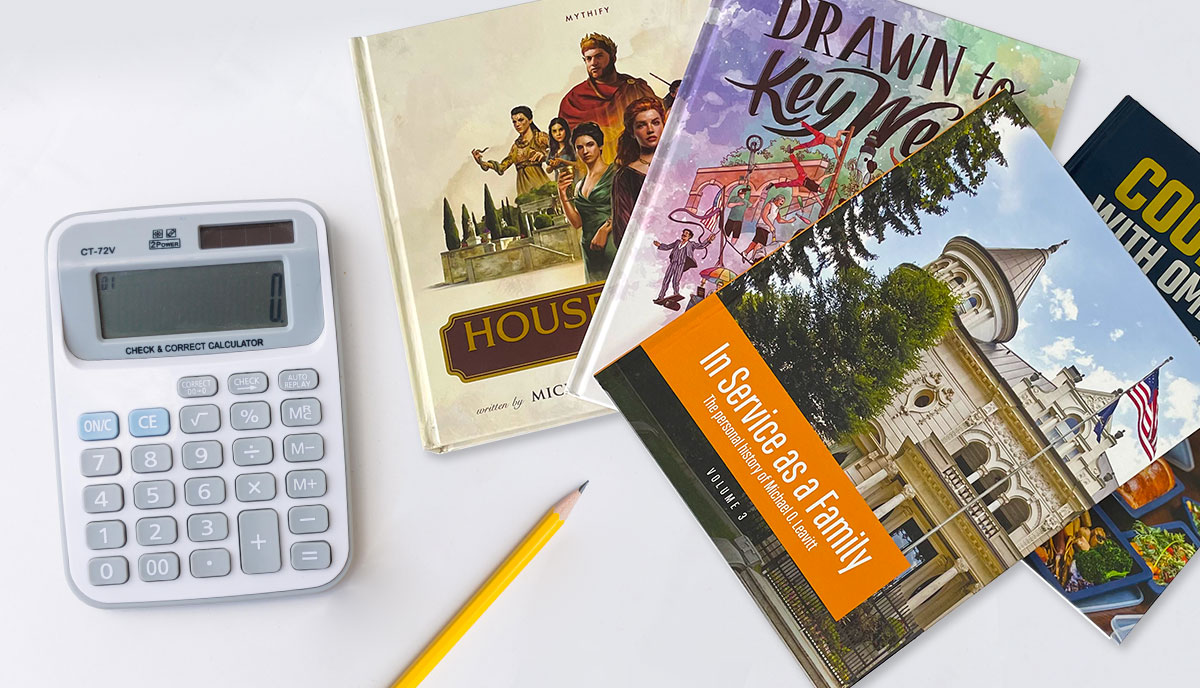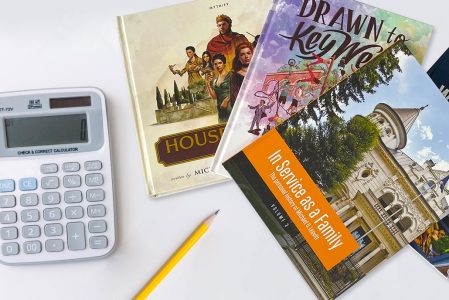We share 12 smart tips to save on the cost of printing your self-published book without sacrificing quality

If you're new to self-publishing, you may want to ‘test the waters' with print-on-demand (POD) publishing services such as Amazon's KDP (Kindle Direct Publishing), IngramSpark, or Lulu. But once you've built a devoted following of eager readers and a strong, responsive email list, you'll more than likely want to join the mass of smart self-publishing ‘authorpreneurs' who take advantage of the cost savings and higher quality of traditional commercial printing. So, let's explain how to save printing costs on your self-published book.
Self-publishing with an offset printer
If you're not sure about the enormous benefits of commercial offset printing for self-publishers, bookmark our post, A Brief Guide to Offset Printing for Self-Publishers first; and then go back to read it after this one. The mistaken idea that traditional printing is more expensive and burdensome than POD has become so ingrained in the culture that many otherwise smart self-publishers are losing out due to propaganda and ignorance. Happily, we're seeing a shift now, as more successful authors discover the amazing product quality and higher profit margins that they can enjoy with a traditional print run.
But we'll be honest with you — we're always honest with you, by the way, it's one of our commitments and strengths as a company — diving straight into traditional digital or offset printing may not be the best option for every writer. You should definitely look into all your options carefully, examine your business plan, calculate your budget, carry out your market research, and then make your own decisions. All we ask is that you don't dismiss traditional printing out-of-hand because of some nonsense you've read about it being more costly and having to stack up thousands of books in your spare room. Maybe that was true 30 years ago. But times, and the printing industry, have moved on.
Costs of POD vs Custom Printing
Just as a quick example, a 250-page POD standard-sized paperback novel with black-and-white interior on cream paper will cost you $3.85 per copy to print with KDP (according to their own online calculator). If you sell it for $9.95, you'll make $2.12 royalty on each copy after Amazon take their $3.98 cut for services rendered. With POD, that price doesn't change however many copies you sell. So, selling 500 copies would cost you $3,915 (printing costs + fees) and you'd pocket $1,060. Maybe you think that sounds like a good deal? Well, think again. Let's examine how to save printing costs on your self-published book with a traditional printer.
Check out and compare the figures if you had a traditional offset print run with us. So, 500 copies of the same book would cost you about $1495 — equivalent to $2.99 a copy and leaving you a gross profit margin of $6.96 per book, a total of $3,480. More than three times what you'd squeeze out of Amazon. That's better, isn't it? And with POD, if you sell 1,000 copies you pay the same price times 1000. But with us, the more copies you order, the less you pay per copy and the more money you make.
Now, as we said before, if it's your first time and you haven't built a readership yet, you might want to get books printed as they sell even though it costs more. But as soon as you have a list to which you know you can directly sell several hundred copies or more, by switching to offset printing, you'll increase your profit margin drastically — even accounting for mailing the books out. And on top of that, you'll get a beautifully made custom book created with state-of-the-art printing technology and the finest materials on the market. Believe us, no POD service offers that.
But what will you do with all those books?
And you may have heard the old chestnut, “But what will you do with 500 books stacked up in your spare room?” The answer to that is — because you've been smart, done your due diligence, and made a calculated decision — you can mail them out immediately because you've pre-sold them to your list! But even if you wanted a run of, say, 5,000 books because you're confident that you'd sell them in the course of a year, you don't need to store them in your spare room! We'll store them for you and mail them to you — even singly — as you need them. The ‘spare room' argument is so outdated we can hardly believe it's still circulating. But then again, some people still believe the Earth is flat, right?
Once you reach a certain point in your career as an independent author, you'll want to take full advantage of everything that professional design and printing services can offer. There's just no comparison between the quality of a POD product and a custom printed book. And once you know you can sell at least a few hundred copies directly to your list, a longer print run makes production orders of magnitude cheaper than anything a print-on-demand service can offer.
But the benefits and savings don't stop there. We've been in the commercial printing business for decades and we've helped countless talented authors take the next step forward in their careers with the best books for the lowest investment. Still, we know that as an independent author, you're in a highly competitive business and up against ‘The Big Five' to boot; so, we'd like to offer you our top tips on how to reduce your self-publishing printing costs even further without sacrificing quality.
How do I reduce printing costs?
Once you decide that custom book printing is the right way forward for your self-publishing business, you really should talk to us as soon as possible. Why? Because it's going to be a new learning curve for you to climb, and talking over your aims and needs with us is free. We can help you make the best decisions and choose the options which will give you the best book within your budget. But just as an example of the many ways you can cut costs without cutting corners, here are 12 top tips for saving money on your printing costs.
12 top tips to save money on book printing
- Make sure that your printer — we won't assume you'll choose us, although we'd like it if you did! — offers you full proofs of your finished book. Make sure to check them carefully. A perfect proof will always lead to a perfect print run. But it's your responsibility to check them and make sure everything is as you want it. Changes made later add further costs.
- Make sure that all your files are ‘print-ready'. Unlike many other printers, we manually check everything before we go to print — because we really care — but if changes need making, it will add time and possibly more costs if one of our designers does the extra work. Of course, if you use one of our in-house designers from the start, that will all be included in your quote and you've nothing to worry about. But if you already have a pet designer or choose to do it yourself, this is vital to get right. To help you, we've published a guide to getting everything ready to go to press: How to Prepare a File for Print Production.
- While we've been talking about offset printing here, it's not your only option. For some projects digital might be a cheaper and sufficient choice. We're expert digital printers, too; so, talk to us about what you have in mind. If you're printing a limited-edition comic, for example, or a prototype test copy, digital could be the better, cheaper way to go.
- As we work together, we'll draw on our extensive knowledge and experience with paper stocks to help you choose the best kind of paper for your book. The details depend on your project. A paperback, a hard cover, a graphic novel, and a coffee table book all have different requirements. But in many cases, notching down the weight of the paper can save you a lot of money without any loss to the visible quality of the printed product.
- Coatings and finishes can also have an impact on the cost of your print run. There are many options from which to choose. Again, the devil is always in the detail, but if you're running close with your budget, ask us how we can help you make savings on this, too.
- Go for a black-and-white interior and keep illustrations and color printing to a minimum. If you need color plates, we can look at how to print good quality reproductions while keeping the costs down by, for example, cutting bleeds or using a reduced palette. Some books — like coffee table books — can't really compromise on the visual elements, but with other projects if we can find a way for you to save money without loss of quality, we will.
- If you're publishing a novel, for example, whether a paperback or a hardback, choose standard print sizes. Going for custom sizes is always a possibility, but if you need to minimize capital outlay, standard sizes are always cheaper and faster to turn around. They're also what your readers are used to and expect, so unless you have a specific reason to do something else, stick with standard.
- While specialist features such as UV spot varnishing, gold or silver foil stamping, metallic inking, die-cutting, embossing, and debossing can add a super-special finishing touch to your book, it's an added cost. So, think carefully and do your math before you ask us to add these lovely but perhaps not wholly necessary effects. Although, if you have the budget, they can also be a good return on investment.
- Printing two or three (or four or five or…) short runs of just a few hundred copies will always cost more than printing longer runs. So, think ahead. If your historical sales figures and current fan base add up to guaranteed sales in the thousands, you'll save money and make more profit if you print them all at once. Of course, that may not fit your business plan. But if you have the budget and you're sure you'll sell them, spending more now will save you a significant amount down the line.
- If you're transitioning from your old, expensive POD model to an offset or custom digital printing service, you'll be used to super-rapid turnaround, with your books typically available in-store within a few days. With offset and traditional custom printing, that will change. We can certainly speed things up, but it will mean added costs. So, to save money, plan ahead and take time over every step.
- When it comes to storage and shipping, talk to us. We can probably help you cut costs here, too. With a range of shipping options available to us — including air and sea — we can help you calculate the most cost-effective way to get your books to where they need to go. And as we mentioned earlier, we also offer up to a year's storage and drip-feed delivery if you don't need all your copies straightaway.
- Think about binding options. POD only offers ‘perfect binding' — which in itself is a good choice for paperback novels, say — but it's not the only option. Talk to us about saddle-stitch binding, or combining saddle stitch with perfect. Depending on your project, we could save you money there, too.
Well, we hoped we've convinced you in an open and transparent way to consider custom offset and digital printing as you build your readership and your self-publishing career. It may not be for everyone, but it's as well to make an informed decision based on the facts rather than outdated myths, rumors, and hearsay. We also hope that we've shown you how to save printing costs on your self-published book whichever print options you choose.
If you'd like to talk to us about your next self-publishing project and how we can help, we'd love to hear from you. Get in touch and one of our experienced, expert, and enthusiastic team will be delighted to listen and advise. And if you'd like a no-obligation quote to compare with your other options, no problem. Just ask.







Hi,
I am a published author and I published my books through Lulu Publishing. They charge me for printing my books and the cost vary according to the book. Right now I have two books with them both with the option of either hardback or softcover. The estimate to print 100 books half hardback and half softcover will be $943.50 and I'm just trying to cut this cost down. I would have to find out if other companies can print my book I mean I own all the rights, so I don't think I would have an issue there but can you guys do better than this price??? Just shopping around???
Hi Thomasina, Lulu is a popular choice for many self-publishing authors and they often do a good job. But you're right that their price/quality ratio isn't always satisfactory for a lot of authors. We're confident that we can offer you a better book at a lower price. And as you own the rights, you can certainly reprint your existing books with us, too. That's no problem. We've asked one of our experts to shoot you an email to get the ball rolling and see how we can best help you. Don't forget to check your spam/junk folder in case it ends up there by accident; and let us know if you need any further support. We're here to help you!